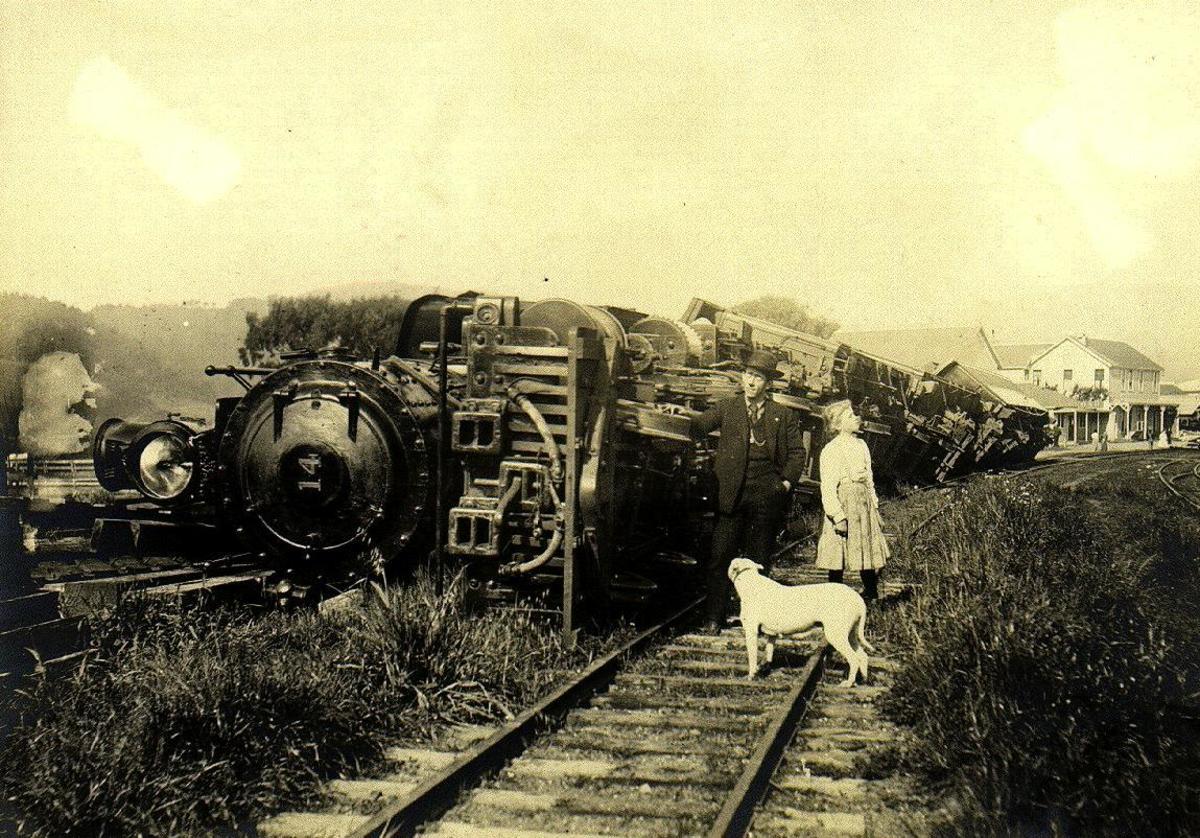Where My Big Earthquake Prediction Went Wrong
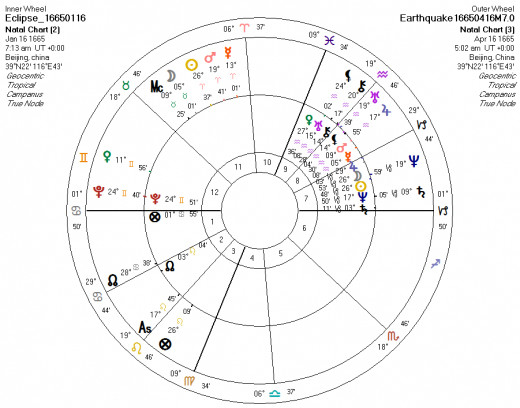
"You've got to pick up every stitch..."
-from the song Season of the Witch by Donovan
The purpose of this article will be to show how an earthquake prediction can be made and also how it should not be attempted. As in knitting one doesn't want to drop a stitch, but if one does the error can be corrected. In order to do so though one must notice that a misstep occurred. That is the big advantage of stitching by hand rather than solely by machine.
Before spelling out exactly where I went wrong, I wish to present the reader with a little story set in 17th century China that should help illustrate some of the points that I wish to eventually make. At the time, Jesuit missionaries were not only attempting to convert key figures within the Chinese government, but they were trying to correct key shortcomings of the Chinese calendar system. This ancient calendar had become inaccurate due to several factors principally due to their astronomer's understanding of the craft eroding over the years due to positions in that field being filled by family members rather than being determined by the astronomer's ability.
It was hard for the Jesuits to convince top officials that change was necessary. A conservative attitude pervaded much of the hierarchy so that when the Jesuit's new calendar system, based on the true motions of the sun and moon, was used and disagreed significantly from the Chinese calendar which used traditional methods, officials accused the Jesuits of creating errors and confusion. Having a newer, more conservative leader at the time didn't help and they were promptly locked up and their fate debated.
With an annular solar eclipse approaching, the Jesuits decided to use that as a way to regain some credibility. It is said that they were able to predict the exact time of the occurrence of the eclipse that could be seen in Beijing, the capital, on January 16, 1665. The Chinese astronomers foretold its occurrence anywhere from one half to three quarters of an hour too early. Unfortunately, the success of the Jesuits only seemed to tick off Chinese officials even more. They were left imprisoned for a few months until their fate of death was handed down by the regents on April 15, 1665, which was to be executed at some point in the near future. But fortunately for the Jesuits a damaging earthquake occurred the next day at about noon that caused a fire in the Imperial Palace. That event, along with the appearance of a comet a few days prior were thought to be omens that their earlier judgement was too harsh and, along with a request for the release of the missionaries by the Empress Dowager, the Jesuits were eventually set free. Unfortunately, apparently to save face, the execution of their Chinese assistants was still carried out.
We will now use the record of this ancient eclipse and earthquake as a test case for my prediction methods. According to present day calculations, the eclipse of 1/16/1665 occurred closest to Beijing (39N22, 116E43) at 0713 UTC (3pm, local mean time of Beijing) and lasted about 7.5 minutes. The earthquake, which was as small as 6.5 in magnitude (for an epicenter near Beijing) or as much as 7.7 in magnitude (for an epicenter further away from Beijing), occurred on 4/16/1665 at about noon, local time. We will use the same geographic coordinates as given above for the closest eclipse path to the capital and use 7.0 as the magnitude.
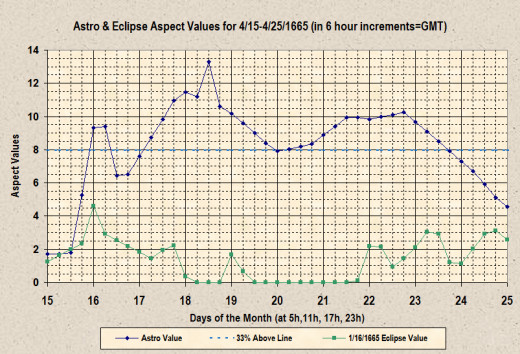
As can be seen in the graphic chart above, the earthquake occurred at the beginning of an 8 day seismic window and just before peaks of the astro-aspect values and the 1/16/1665 eclipse aspect values. The eclipse value at the time of the earthquake event was comprised by the position of the sun being in a 90 degree aspect to its position that it and the moon occupied three months earlier; at the time of the eclipse. The position of the moon at the time of the earthquake was also 90 degrees from the position of mercury at the time of the eclipse. If this quake actually occurred at 12:45pm, then the moon would have been exactly at a key position in the sky which often corresponds to the occurrence of earthquakes. Since, at the time, the Chinese divided the day into twelve segments of two hours each and historical records usually only referred to events occurring within one of these divisions, the time given, or being in the 11am to 1pm segment, is only accurate to within an hour. Since all factors work better if it occurred at 12:45pm, we will adopt that as the accurate time of the earthquake (or about 5am, GMT or 0500 UTC).
Interestingly, in the eclipse chart (shown at the top of this article), all the planets except for pluto are within a grouping spanning just 54.5 degrees. This may seem to be powerful, but without a planet in a hard aspect such as a square (90 degree angle aspect) or opposition (180 degree aspect) linked to the grouping, its energy is dormant. But three months later, when the sun and moon were simultaneously in hard aspects with the group; the sun square the eclipse degree and the moon square mercury which was at the center of the grouping and tied to the other planets in it via midpoints; an earthquake was the result.
With my current prediction I relied too much on my computer program to find peaks of key aspects that relate to earthquakes, but I skipped over evaluating the data to see how or if these aspects interacted to form complex formations or if instead they were isolated. If it was the later then the aspects could in theory cancel each other out (one harmonious aspect + one hard aspect = zero effect). If it was the former then the aspects would magnify each other and equal more than the sum of their parts. Let us now look back and see what I should have observed before taking a leap of faith and making a short sighted prediction.
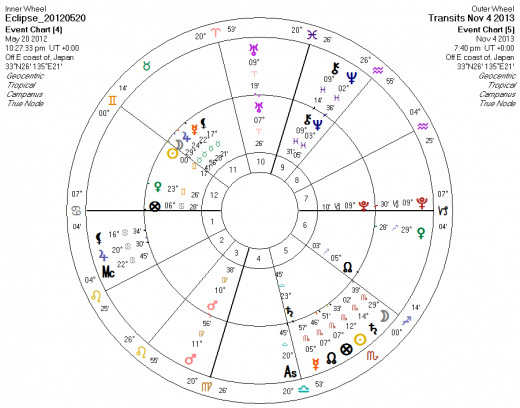
In the bi-wheel astro chart for the 5/20/12 eclipse and 11/4/13 transits we see the transiting moon opposite the eclipse degree. This would seem to be significant, but the common triggers of mars or the sun to the ecliptic degree are absent. Transiting mars is close to its position for the time of the eclipse, but this planet is isolated from the rest of the chart (lacking aspects to other planets) and thus that contact is wasted.
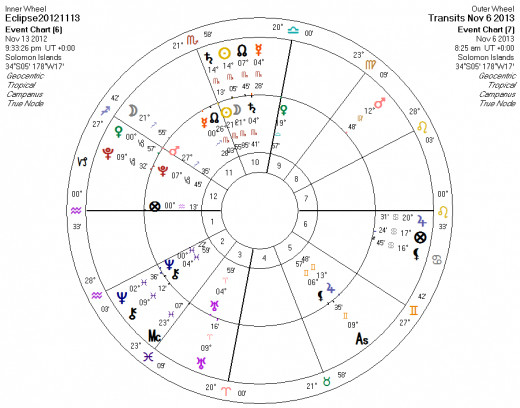
In the bi-wheel astro chart for the 11/13/12 eclipse and 11/6/13 transits we see the transiting sun 30 degrees away from the midpoint of the eclipse positions of mercury and mars. Unfortunately the degrees between the midpoint and either one of those planets is not divisible by 7.5, 18 or 11.25 degrees so there is no outlet for the energies inherent in that midpoint structure. The transiting moon is also 30 degrees from the eclipse degree but, similar to the case in the previous example, the moon alone isn't enough of a trigger like the sun or mars would be. There just wasn't enough planetary interactions to be able to tap the eclipse energies that were stored up so no earthquakes materialized.
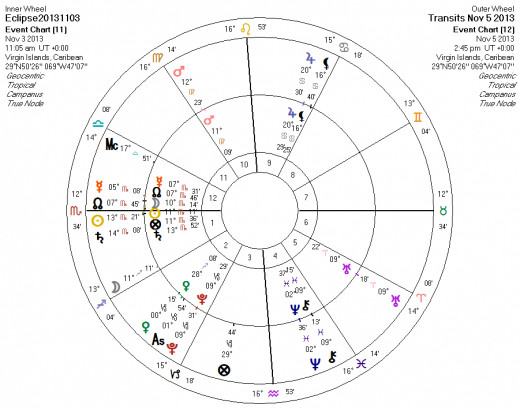
In the case of the latest hybrid eclipse of 11/3/13, that one occurred too soon before the seismic window opened. The regular astro-aspect value peak occurred just two days after that eclipse and one of the aspects that the computer counted as relevant (transiting mars conjunct its eclipse position) wasn't valid because the aspect needs to move away and then return later for it to be effective. Also the transiting sun is 33d45m from the midpoint of the eclipse positions of mercury and mars, but the degree angles between the midpoint and each of those planets doesn't produce results that can release any pent up force. We are left with the transiting moon in a 30 degree aspect to the eclipse degree, but it is not enough without other factors to be an influence.
What in effect happened was I was predicting on auto pilot at a time when manual observations were required. I had believed that it wasn't necessary to do that because, with three eclipse peaks occurring around the time of a significantly large astro-aspect value peak it was believed that at least one, perhaps two of them should have been effective. I should have thought to myself that predicting damaging earthquakes is too important to assume anything. In the future I intend to make it a point to scrutinize the situation more closely instead of jumping to any premature conclusions.
The Mathematics of the Chinese Calendar by Helmer Aslaksen
- http://www.math.nus.edu.sg/aslaksen/calendar/cal.pdf
See pages 42 through 46 (the last 5 pages of this article) for details related to part of the above hub.
© 2013 Joseph Ritrovato

